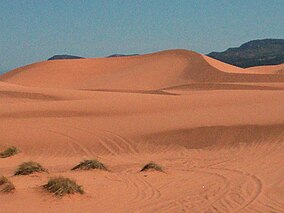| Coral Pink Sand Dunes State Park | |
|---|---|
| IUCN category V (protected landscape/seascape) | |
 The sand that makes up the pink-colored dunes is derived from the Navajo Sandstone The sand that makes up the pink-colored dunes is derived from the Navajo Sandstone | |
  | |
| Location | Kane, Utah, United States |
| Coordinates | 37°2′16″N 112°43′13″W / 37.03778°N 112.72028°W / 37.03778; -112.72028 |
| Area | 3,730 acres (15.1 km) |
| Elevation | 6,000 ft (1,800 m) |
| Established | 1963 |
| Visitors | 229,527 (in 2022) |
| Governing body | Utah State Parks |
Coral Pink Sand Dunes State Park is a state park in southwestern Utah, United States, located between Mount Carmel Junction and Kanab, south and west of U.S. Highway 89 in Kane County. The park features uniquely pink-hued sand dunes located beside red sandstone cliffs.
The dunes are formed from the erosion of pink-colored Navajo Sandstone surrounding the park. High winds passing through the notch between the Moquith and Moccasin Mountains pick up loose sand particles and then drop them onto the dunes as a result of the Venturi effect. The dunes are estimated to be between 10,000 and 15,000 years old.
The park allows camping, hiking, off-road vehicle driving, and photography. There is a conservation area of 265 acres (1.07 km), and the total grounds include 3,370 acres (13.6 km). It was established as a Utah state park in 1963.
Sandboarding is also a popular activity, sandboards and sand sleds can be rented directly at the park.
The Coral Pink Sand Dunes tiger beetle (Cicindela albissima) is endemic to the dunes, being found nowhere else in the world. The park also contains most of the remaining individuals of the rare plant known as Welsh's milkweed (Asclepias welshii), a federally listed threatened species.
Gallery
-
Sand from the dunes: grains of quartz with a hematite coating providing the orange color.
-
 Part of the field of sand dunes.
Part of the field of sand dunes.
-
 Coral Pink Sand Dunes tiger beetle (Cicindela albissima)
Coral Pink Sand Dunes tiger beetle (Cicindela albissima)
References
- "Coral Pink Sand Dunes General Management Plan" (PDF). Utah State Parks. February 2005. Retrieved February 4, 2011.
- ^ "Coral Pink Sand Dunes State Park: About the Park". Utah State Parks. Archived from the original on March 16, 2011. Retrieved February 4, 2011.
- "Park Visitation Data". Utah State Parks. July 6, 2023.
- ""Sandboarding at Coral Pink Sand Dunes"". Retrieved March 21, 2022.
- "Coral Pink Sand Dunes tiger beetle (Cicindela albissima)". U.S. Fish and Wildlife Service. Archived from the original on October 19, 2011. Retrieved April 21, 2013.
- "Coral Pink Sand Dunes Tiger Beetle". Utah Division of Wildlife Resources. Archived from the original on December 31, 2012. Retrieved April 21, 2013.
- "Asclepias welshii". Center for Plant Conservation. September 28, 2010. Archived from the original on December 15, 2010.
External links
 Coral Pink Sand Dunes State Park travel guide from Wikivoyage
Coral Pink Sand Dunes State Park travel guide from Wikivoyage- Official Coral Pink Sand Dunes State Park website
- Sandboarding in Utah